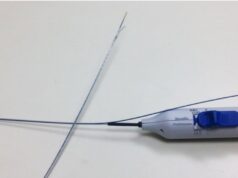
Research published in Phlebology has indicated that the 2013 UK varicose veins clinical guidelines have led to “a considerable increase” in leg ulcer patient referrals, although many patients are still not being referred early enough, the authors of the paper argue.
The UK National Institute for Health and Care Excellence (NICE) Clinical Guideline (CG) 168, was published in July 2013 with the aim of improving care of patients with leg ulcers—“ a common cause of morbidity and disability and result in significant health and social care expenditure,” according to lead author Huw OB Davies (University of Birmingham, Birmingham, UK) and colleagues. The guidelines recommended, amongst other key priorities, that patients with a break in the skin below the knee that had not healed within two weeks be referred to a specialist vascular service for diagnosis and management.
Davies and colleagues worked to determine the impact of CG168 on referrals to a leg ulcer service, comparing referral data during an 18-month period prior to CG168 (January 2012–June 2013) and an 18-month period commencing six months after (January 2014–June 2015) publication of the guideline.
The team found a two-fold increase in referrals (181 patients, 220 legs vs. 385 patients, 453 legs) but no change in mean age, gender or median-duration of ulcer at referral (16.6 vs. 16.2 weeks). Mean-time from referral to specialist appointment increased (4.8 vs. 6 weeks, p=0.0001), as did legs with superficial venous insufficiency (36% vs. 44%, p=0.05). There was a trend towards more superficial venous insufficiency endovenous interventions (32% vs. 39%, p=0.271) with an increase in endothermal (2 vs. 32 legs, p=0.001) but no change in sclerotherapy (24 vs. 51 legs) treatments. In both groups, 62% legs had compression. There was a reduction in legs treated conservatively with simple dressings (26% vs. 15%, p=0.0006).
“Since CG168, there has been a considerable increase in leg ulcer referrals,” write Davies et al. “However, patients are still not referred until ulceration has been present for many months. Although many ulcers are multifactorial and the mainstay of treatment remains compression, there has been an increase in superficial venous insufficiency endovenous intervention.”
However, Davies et al note, “we are aware of a reluctance to apply adequate compression in primary care due to poor patient compliance and concerns about potentially undiagnosed significant arterial disease. In addition, a significant minority of ulcers are not vascular and it is particularly important that a malignant aetiology is not missed.”
In order to continue improvement in early patient referral, “Further efforts are required to persuade community practitioners to refer patients earlier, to educate patients and to encourage further investment in chronically underfunded leg ulcer services.” These steps, the authors write, would “also be aided by the amalgamation of differing sources of NICE guidelines/clinical knowledge summary to clarify advice for the community practitioners who will refer patients for specialist opinion.”












